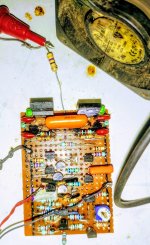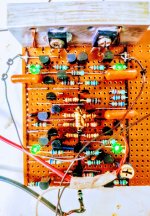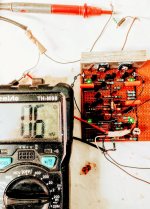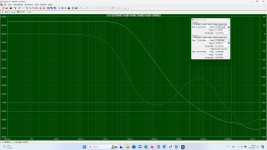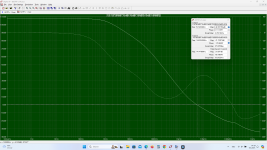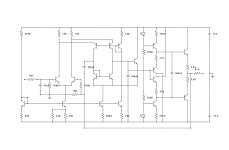D
Deleted member 550749
D
Deleted member 550749
Hi MrAK87,Made this , Circuit working, it has only one problem, whenever I remove input signal,getting dc9v plus out and when connecting signal from phone jack it's become 1.8mv offset and works, why without signal or any input connection getting DC out and circuit not working 🤔 any fix?
Since you were brave enough to try the given schematic, I must warn you that the circuit is not stable... To achieve minimum stability for a gain of ~6 (1+5k9/1k2), modify the existing pcb as given in the attachments (depending on the used transistors). Good luck...
Attachments
D
Deleted member 550749
It's working and better offset +0.6mv and sound is very good , thanks for the schematic 🙏Hi MrAK87,
Since you were brave enough to try the given schematic, I must warn you that the circuit is not stable... To achieve minimum stability for a gain of ~6 (1+5k9/1k2), modify the existing pcb as given in the attachments (depending on the used transistors). Good luck...
♥️👏👍😊
Attachments
Hi Mark,
My intention was to provide the guys/gals with a sufficiently stable AD797 discrete concept and that at this initial stage meant sacrificing something to get something else...so I purposely sacrificed the noise performance with 100R on the differential emitters to get a decent GM of about 23dB and PM of 68dB for a gain of ~6 and keep the compensation capacitor values low enough to get good enough THD numbers to make the exercise worthwhile.
EDIT: I ran the simulation again with and without the 100R degenerate resistors to see the difference in stability...seems like I didn't gain much in terms of stability and added unnecessary noise in the process, so it looks like they can be safely removed/bypassed...thx Mark.
For anything more than that (something remotely approaching the performance of the monolithic AD797 in terms of noise, THD, unity gain stability, thermal stability, clipping, SR, etc...) well...that's a whole different game and not everyone is up to the challenge.
My intention was to provide the guys/gals with a sufficiently stable AD797 discrete concept and that at this initial stage meant sacrificing something to get something else...so I purposely sacrificed the noise performance with 100R on the differential emitters to get a decent GM of about 23dB and PM of 68dB for a gain of ~6 and keep the compensation capacitor values low enough to get good enough THD numbers to make the exercise worthwhile.
EDIT: I ran the simulation again with and without the 100R degenerate resistors to see the difference in stability...seems like I didn't gain much in terms of stability and added unnecessary noise in the process, so it looks like they can be safely removed/bypassed...thx Mark.
For anything more than that (something remotely approaching the performance of the monolithic AD797 in terms of noise, THD, unity gain stability, thermal stability, clipping, SR, etc...) well...that's a whole different game and not everyone is up to the challenge.
Attachments
The uniqueness in the AD797 is the neutralisation cap Cn - this is NOT negative feedback, it is positive feedback.AD797 is very good, but it is not unique.
For exanple AD847 and AD8021 uses the same folded cascode idea.
View attachment 1280469 View attachment 1280470
By balancing the neg and pos feedback it gets it extremely low distortion.
There's articles on the 'net to explain this Scott Wurcer genius design.
If you don't 'get' this basic point, how can you 'clone' that opamp??
Jan
I am mystified too why the "floating current mirror" is included without this local feedback loop included. Maybe I am missing something?The uniqueness in the AD797 is the neutralisation cap Cn - this is NOT negative feedback, it is positive feedback.
By balancing the neg and pos feedback it gets it extremely low distortion.
There's articles on the 'net to explain this Scott Wurcer genius design.
If you don't 'get' this basic point, how can you 'clone' that opamp??
Jan
D
Deleted member 550749
D
Deleted member 550749
The connection of the feedback (10k) and the gain setting resistor (1k) towards the output is incorrectly drawn... as it is now you have 0dB gain and problems with stability almost certainly.This one also fixed , I think now this one simple and better 👍
- Home
- Amplifiers
- Solid State
- AD797 Clone people! Who can make a better one.
